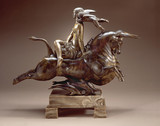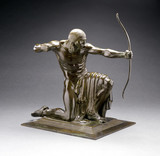During the thirty years between 1915 and 1945 many considered Paul Howard Manship to be the nation’s greatest sculptor. He studied painting and sculpture at the Saint Paul Institute of Art before going in 1905 to New York, where he attended the Art Students League. He spent a year as assistant to the sculptor Solon H. Borglum (1868-1922) in Mamaroneck, New York. He next studied at the Pennsylvania Academy of the Fine Arts in Philadelphia with Charles Grafly (1862-1929) and assisted Isidore Konti (1862-1938). In 1909 Manship won a three-year scholarship to the American Academy in Rome. His introduction there to ancient art, particularly archaic Greek sculpture, profoundly influenced his mature style. He returned to New York late in 1912 and married early the following year. He almost immediately encountered success. Election to the National Academy of Design in 1916 was only one of many honors that came to Manship early.
During World War I he served with the Red Cross in Italy and afterward lived in London and then in Paris. In 1927 he established his permanent residence and studio in New York, although he also maintained a studio in Paris until 1937. During World War II he built a summer home and studio in Gloucester, Massachusetts. Although after the war he continued to receive important civic commissions, he increasingly was regarded as an arch-conservative.
BIBLIOGRAPHY
Archiv. Am. Art, Paul Manship Papers § Paul Vitry, Paul Manship: Sculpteur américain, Artistes étrangères contemporaines Series (Paris: Editions de la Gazette des Beaux-Arts, 1927), with catalogue of principle works § Edwin Murtha, Paul Manship (New York: Macmillan, 1957), with catalogue raisonné, chronology, bibliography § Saint Paul, Minnesota Museum of Art, and others, Paul Manship: Changing Taste in America, exh. cat., 1985, with essays by Harry Rand, Frederick D. Leach, Susan Rather, and others, bibliography § Harry Rand, Paul Manship (Washington, D.C.: Smithsonian Institution Press, 1989), with bibliography, published in conjunction with an exhibition held at the National Museum of American Art, Smithsonian Institution, Washington, D.C., and others, 1989-91.


